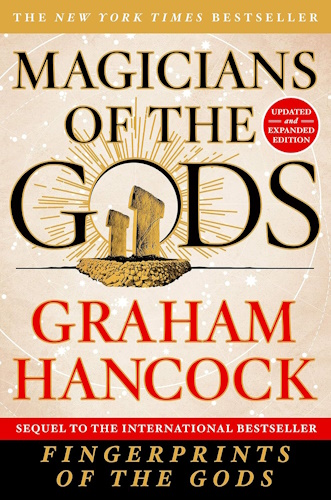

Magicians of the Gods: Updated and Expanded Edition - Sequel to the International Bestseller Fingerprints of the Gods

With over 5 million copies sold worldwide of Fingerprints of the Gods, its New York Times bestselling sequel Magicians of the Gods brings new evidence supporting Hancock's thesis that a global cataclysm wiped out a great global civilization.
On the heels of the very successful hardcover edition, Hancock returns with this paperback version including three new chapters brimming with recent reporting of fresh scientific advances (ranging from DNA to astrophysics) that substantially support his case.
Twenty years ago, Graham Hancock published Fingerprints of the Gods an astonishing, deeply controversial investigation of the mysteries of and the evidence for Earth's lost prehistoric civilization. Twenty years after this massive bestseller debuted, Hancock returns with its sequel, filled with completely new scientific and archaeological evidence.
Since 2007, a host of new proof has come to light supporting his theories through new archaeological discoveries. He travels to a wholly different set of ancient sites, including Gobekli Tepe, and brings entirely up to date and exciting material to the table for fans eagerly awaiting more evidence in favor of the prehistoric civilization. And, even more intriguing, he proposes an answer to the one question he could not answer in Fingerprints what caused this civilization to disappear. Magicians is poised perfectly for what his fans want to hear as well as for ushering in a new generation of readers.
About the Author
GRAHAM HANCOCK is the author of the major international non-fiction bestsellers including The Sign and the Sealand Fingerprints of the Gods. His books have sold more than seven million copies worldwide and have been translated into thirty languages. His public lectures, radio and TV appearances, including TV series, Quest For The Lost Civilization and Flooded Kingdoms of the Ice Age, as well as his strong presence on the internet, have put his ideas before audiences of tens of millions. He resides in the UK.
Paperback: 608 pages
Publisher: A Thomas Dunne Book for St. Martin's Griffin; Updated, Expanded edition (January 31, 2017)


The White & Aryan Civilizations: (Caucasian Civilization) (Volume 1)

Information to Remember If you are a member of the White Aryan people from countries controlled by “New Christian” religions, you should ask yourself who diverted us to study Egyptian civilization instead of the white Aryan peoples’ Civilization. Note Roman Empire rulers and Jewish scholars changed Jesus of Nazareth’s “original Christian” religions to “New Christian” Religions to serve their interests only. If you are a member of the White Aryan people from countries controlled by “Islamic” Religions, you should ask yourself who gave your heritage to Persian of Tamil, who is not from White Aryan people by blood. Persian of Tamil betrayed the White Aryan people and joined Jewish leaders for the destruction and transformation of the Median Empire in the year 522 BCE based on Lord Shiva teaching. If you are a member of the White Aryan people from countries controlled by “Deva” religions of India, you should ask yourself how followers of the Devas’ and Asuras’ religion of Lord Shiva teaching were able to destroy and transform the Mitra and Aryan religions in the world. The information below will be repeated few times to get readers attention. Queen Esther was one of the famous Jewish leader's conspiracies against Median Empire royal family. Through Queen Esther, they were able to steal the secret of Magi and their astrology science for prediction. And those Jewish families are using that knowledge to take over the World Economy now.
Series: Caucasian Civilization (Book 1)
Paperback: 504 pages
Publisher: CreateSpace Independent Publishing Platform; 1 edition (August 28, 2016)
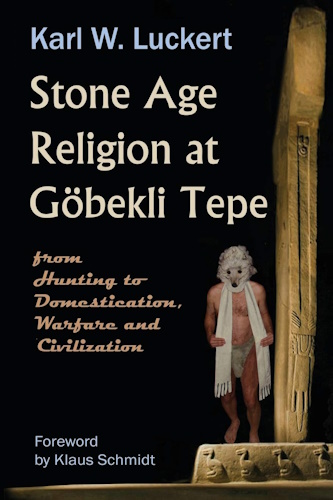

img src="//realityroars.com/images/affiliate-creative/stone-age-religion-at-goebekli-tepe.jpg" height="160" border="0" alt="Stone Age Religion at Goebekli Tepe" title="Stone Age Religion at Goebekli Tepe" style="float:left; margin-right:10px;">
Stone Age Religion at Goebekli Tepe

Excavation of Goebekli Tepe has revealed the hitherto unknown religion of the "Neolithic Revolution." Almost twelve millennia ago the cult was established, at the northern end of the Fertile Crescent, by priests who were hunter-shamans, miners of flint and weapon-makers. Progress in weapon manufacture resulted in overhunting, a temporary surplus of meat, too many human hunters, and a decline in prey animal populations. Shortages of prey animals elicited a priestly cult that specialized in the regeneration of life. Priestly minds rationalized taking control of plants and animals and thereby encouraged domestication--which led to "hyper-domestication," or, what evolved as our history of civilization and our history of religions.
Paperback: 348 pages
Publisher: triplehood (June 13, 2013)
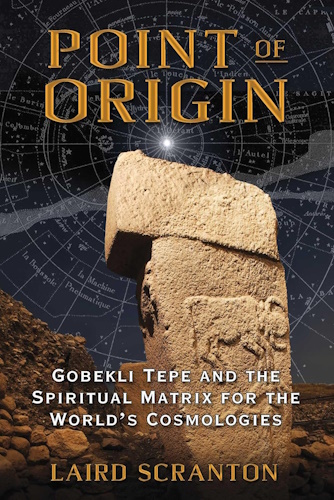

Point of Origin: Gobekli Tepe and the Spiritual Matrix for the World’s Cosmologies

Reveals Gobekli Tepe as a center of civilizing knowledge for the ancient world
- Details how symbolic elements at Gobekli Tepe link a pre-Vedic cult in India to cosmological myths and traditions in Africa, Egypt, Tibet, and China
- Discusses how carved animal images at Gobekli Tepe relate to stages of creation and provide an archaic foundation for symbolic written language
- Defines how classical elements of ancient Egyptian myth and religion characterize an archaic cosmological tradition that links ancestrally back to Gobekli Tepe
How could multiple ancient cultures, spanning both years and geography, have strikingly similar creation myths and cosmologies? Why do the Dogon of Africa and the civilizations of ancient Egypt, India, Tibet, and China share sacred words and symbols? Revealing the existence of a long-forgotten primal culture and the world’s first center of higher learning, Laird Scranton shows how the sophisticated complex at Gobekli Tepe in Turkey is the definitive point of origin from which all the great civilizations of the past inherited their cosmology, esoteric teachings, and civilizing skills, such as agriculture, metallurgy, and stone masonry, fully developed.
Scranton explains how the carved images on Gobekli Tepe’s stone pillars were the precursors to the sacred symbols of the Dogon, Egyptians, Tibetans, and Chinese as well as the matriarchal Sakti cult of ancient Iran and India. He identifies Gobekli Tepe as a remote mountain sanctuary of higher knowledge alluded to in Sakti myth, named like an important temple in Egypt, and defined in ancient Buddhist tradition as Vulture Peak. Scranton reveals how Gobekli Tepe’s enigmatic “H” carvings and animal symbolism, symbolic of stages of creation, was presented as a kind of prototype of written language accessible to the hunter-gathers who inhabited the region. He shows how the myths and deities of many ancient cultures are connected linguistically, extending even to the name of Gobekli Tepe and the Egyptian concept of Zep Tepi, the mythical age of the “First Time.”
Identifying Gobekli Tepe not only as the first university but also as the first temple, perhaps built as a civilizing exercise, Scranton definitively places this enigmatic archaeological site at the point of origin of civilization, religion, and ancient science.
About the Author
Laird Scranton is a recognized authority on Dogon mythology and symbolism. A frequent guest on radio programs such as Coast to Coast AM and Red Ice Radio, he has been a featured speaker at national conferences on ancient mysteries, including the Paradigm Symposium. He is the author of several books, including The Science of the Dogon and China’s Cosmological Prehistory. He lives in Albany, New York.
Paperback: 224 pages
Publisher: Inner Traditions; First Edition edition (February 22, 2015)
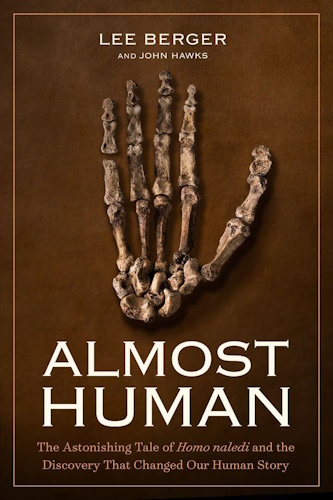

Almost Human: The Astonishing Tale of Homo naledi

This first-person narrative about an archaeological discovery is rewriting the story of human evolution. A story of defiance and determination by a controversial scientist, this is Lee Berger's own take on finding Homo naledi, an all-new species on the human family tree and one of the greatest discoveries of the 21st century.
In 2013, Berger, a National Geographic Explorer-in-Residence, caught wind of a cache of bones in a hard-to-reach underground cave in South Africa. He put out a call around the world for petite collaborators—men and women small and adventurous enough to be able to squeeze through 8-inch tunnels to reach a sunless cave 40 feet underground. With this team of "underground astronauts," Berger made the discovery of a lifetime: hundreds of prehistoric bones, including entire skeletons of at least 15 individuals, all perhaps two million years old. Their features combined those of known prehominids like Lucy, the famous Australopithecus, with those more human than anything ever before seen in prehistoric remains. Berger's team had discovered an all new species, and they called it Homo naledi.
The cave quickly proved to be the richest primitive hominid site ever discovered, full of implications that shake the very foundation of how we define what makes us human. Did this species come before, during, or after the emergence of Homo sapiens on our evolutionary tree? How did the cave come to contain nothing but the remains of these individuals? Did they bury their dead? If so, they must have had a level of self-knowledge, including an awareness of death. And yet those are the very characteristics used to define what makes us human. Did an equally advanced species inhabit Earth with us, or before us? Berger does not hesitate to address all these questions.
Berger is a charming and controversial figure, and some colleagues question his interpretation of this and other finds. But in these pages, this charismatic and visionary paleontologist counters their arguments and tells his personal story: a rich and readable narrative about science, exploration, and what it means to be human.
About the Author
LEE R. BERGER is the Research Professor in Human Origins and the Public Understanding of Science at the University of the Witwatersrand in Johannesburg, South Africa, and a National Geographic Explorer-in-Residence. He was a founder of the Palaeoanthropological Scientific Trust, today the largest nonprofit organization in Africa supporting research into human origins. The director of one of the largest paleontological projects in history, leading over 100 researchers in investigations of the Malapa site in South Africa, Berger is the author of more than 200 scholarly and popular works. His research has been featured three times on the cover of Science and has been named among the top 100 science stories of the year by Time, Scientific American and Discover magazine on numerous occasions. Berger has appeared in many television documentaries on subjects related to archaeology, paleoanthropology, and natural history, and has appeared widely on television and radio, including NPR's Talk of the Nation, Morning Edition, and All Things Considered and PBS's News Hour and Alan Alda's Scientific American Frontiers. Berger was named one of Time magazine's 100 Most Influential People of 2015 and 2016's Rolex National Geographic Explorer of the Year.
JOHN HAWKS is the Vilas-Borghesi Distinguished Achievement Professor of Anthropology at the University of Wisconsin—Madison. He is the author of a widely read paleoanthropology blog, johnhawks.net. Hawks graduated from Kansas State University in 1994 with degrees in French, English, and anthropology. He received both his M.A. and Ph.D. in anthropology from the University of Michigan. After working as a postdoctoral fellow at the University of Utah, he moved to the University of Wisconsin—Madison, where he is currently a member of the anthropology department, teaching courses including human evolution, biological anthropology, and hominid paleoecology.
Hardcover: 240 pages
Publisher: National Geographic; First Edition edition (May 9, 2017)
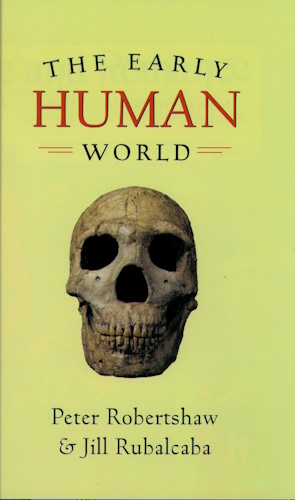

A six-million-year-old jaw bone in Ethiopia proves to be a piece of the earliest hominid discovered-so far. Big Mama, who used a tree branch to escape from a zoo in Holland, is found sipping chocolate milk at a local restaurant. Nandy, a 50,000-year-old skeleton surrounded by flower pollen in Iraq, casts doubt on the beastly reputation of an early hominid. Found frozen in the Alps, Ötzi reveals what people in Europe ate 5,000 years ago. Ardipithecus ramidus kadabba, a chimpanzee, a Neandertal, and the Iceman are just some of the characters who make up The Early Human World.
Peter Robertshaw and Jill Rubalcaba tell the story of early human life using an incredible variety of primary sources: 3.5-million-year-old footprints preserved by a volcano provide evidence of our ancestors' walking on two legs. Stone flakes fashioned 2 million years ago prove early hominids used tools. Bears, lions, and rhinoceroses painted in a cave 30,000 years ago reveal our ancestors' artistic side. An 8,500-year-old dog grave shows the extraordinarily long history of man's best friend. This evidence helps archaeologists decipher not just how we came to be the Homo sapiens we are today, but also what life may have been like for our earliest ancestors. The first Australians encountered freakishly gigantic beasts: kangaroos as big as houses and tortoises the size of cars. The Sahara Desert was once a fertile land, supporting herds of cattle, sheep, and goats. The Early Human World takes readers to sites around the world as archaeologists piece together the clues to our past.
About the Author
Peter Robertshaw is an archaeologist and professor of anthropology at California State University, San Bernardino. His research focuses on the later prehistory and precolonial history of sub-Saharan Africa and has been supported by the National Science Foundation, the National Geographic Society, and the National Endowment for the Humanities.
Jill Rubalcaba began her working life as a college- and high-school mathematics teacher, all the while continuing to go to school to study more math, writing, and business. Later she worked as an engineer on the Patriot Missile. Ms. Rubalcaba is grateful to her children, Kelly and Dan, for showing her the joys of writing for children. Jill Rubalcaba is the author of several books for young adults, including The Wadjet Eye, Place in the Sun, and The Early Human World.
Series: The World in Ancient Times
Hardcover: 176 pages
Publisher: Oxford University Press; 1 edition (February 10, 2005)
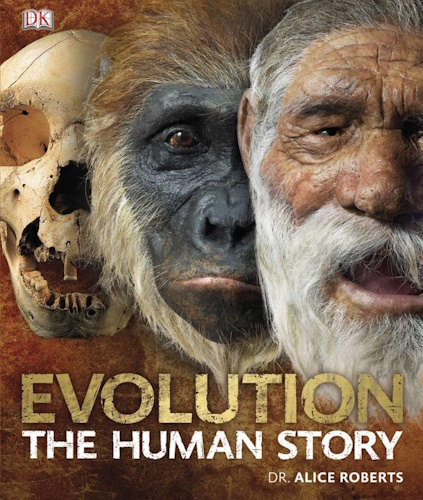

How did we develop from simple animals inhabiting small pockets of forest in Africa to the dominant species on Earth? Traveling back almost eight million years to our earliest primate relatives, Evolution: The Human Story charts the development of our species from tree-dwelling primates to modern humans.
Investigating each of our ancestors in detail and in context, from the anatomy of their bones to the environment they lived in, Evolution: The Human Story profiles every human relative and ancestor discovered to date, and illustrates them in lifelike form.
Amazingly realistic CGI and model reconstructions by the renowned Dutch paleoartists, the Kennis brothers, bring us face-to-face and eye-to-eye with some of our distant ancestors, portraying them as never before.
Drawing on cutting-edge research and the latest theories to reveal new and surprising elements, shining a light on previously inaccessible and unimagined detail, Evolution: The Human Story takes on a depth and fascination that is hard to resist.
About the Author
DK was founded in London in 1974 and is now the world's leading illustrated reference publisher and part of Penguin Random House, formed on July 1, 2013. DK publishes highly visual, photographic nonfiction for adults and children. DK produces content for consumers in over 87 countries and in 62 languages, with offices in Delhi, London, Melbourne, Munich, New York, and Toronto. DK's aim is to inform, enrich, and entertain readers of all ages, and everything DK publishes, whether print or digital, embodies the unique DK design approach. DK brings unrivalled clarity to a wide range of topics with a unique combination of words and pictures, put together to spectacular effect. We have a reputation for innovation in design for both print and digital products. Our adult range spans travel, including the award-winning DK Eyewitness Travel Guides, history, science, nature, sport, gardening, cookery, and parenting. DK’s extensive children’s list showcases a fantastic store of information for children, toddlers, and babies. DK covers everything from animals and the human body, to homework help and craft activities, together with an impressive list of licensing titles, including the bestselling LEGO® books. DK acts as the parent company for Alpha Books, publisher of the Idiot's Guides series and Prima Games, video gaming publishers, as well as the award-winning travel publisher, Rough Guides.
Hardcover: 256 pages
Publisher: DK; unknown edition (August 15, 2011)
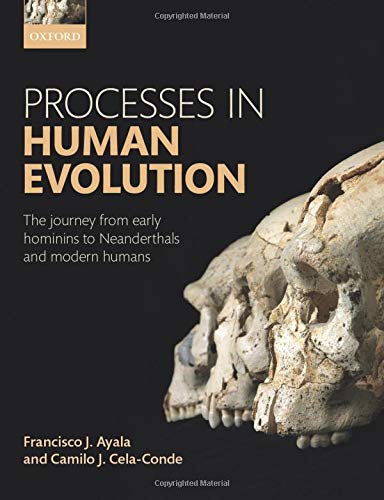

Processes in Human Evolution: The journey from early hominins to Neanderthals and modern humans

The discoveries of the last decade have brought about a completely revised understanding of human evolution due to the recent advances in genetics, palaeontology, ecology, archaeology, geography, and climate science. Written by two leading authorities in the fields of physical anthropology and molecular evolution, Processes in Human Evolution presents a reconsidered overview of hominid evolution, synthesising data and approaches from a range of inter-disciplinary fields. The authors pay particular attention to population migrations - since these are crucial in understanding the origin and dispersion of the different genera and species in each continent - and to the emergence of the lithic cultures and their impact on the evolution of cognitive capacities.
Processes in Human Evolution is intended as a primary textbook for university courses on human evolution, and may also be used as supplementary reading in advanced undergraduate and graduate courses. It is also suitable for a more general audience seeking a readable but up-to-date and inclusive treatment of human origins and evolution.
About the Author
Francisco J. Ayala, University Professor and Donald Bren Professor of Biological Sciences, University of California, Irvine,Camilo J. Cela-Conde, Director of the Laboratory of Human Systematics and Professor of Anthropology, University of Balearic Islands
Francisco J. Ayala is University Professor and Donald Bren Professor of Biological Sciences and Professor of Philosophy at the University of California, Irvine. Prof. Ayala is a member of the National Academy of Sciences, a recipient of the 2001 National Medal of Science, and served as Chair of the Authoring Committee of Science, Evolution, and Creationism. Dr Ayala has received numerous awards, including the 2010 Templeton Prize for 'exceptional contribution to affirming life's spiritual dimension' and 23 honorary degrees from universities in ten countries. He has been President and Chairman of the Board of the American Association for the Advancement of Science and President of Sigma Xi, the Scientific Research Society of the United States. Dr. Ayala has written numerous books and articles about science and religion, including Darwin's Gift to Science and Religion (Joseph Henry Press, 2007), Am I a Monkey? (Johns Hopkins University Press, 2010), and The Big Questions. Evolution (Quercus, 2012).
Camilo J. Cela-Conde is Senior Professor of the Department of Philosophy, University of Balearic Islands (UIB, Palma de Mallorca, Spain) and Director of the Laboratory of Human Systematics (UIB). He is a member of the Institute of Interdisciplinary Physics and Complex Systems (IFISC), Universidad de las Islas Baleares & Consejo Superior de Investigaciones Cientificas (Palma de Mallorca and Madrid, Spain), and a Fellow of the American Association for the Advancement of Science USA (Biology section). He is also a member of the Center for Academic Research and Teaching in Anthropogeny, Salk Institute and University of California, San Diego (USA), elected in March, 2008. He has leadered several expeditions as follows. Kenya; Expedition to Tugen Hills, Baringo Lake District, year 2005, research on early cultural tools. Tanzania; Expedition to Natron Lake, year 2006, research on Hadza hunter-gatherers behavior.
Paperback: 560 pages
Publisher: Oxford University Press; 1 edition (May 16, 2017)
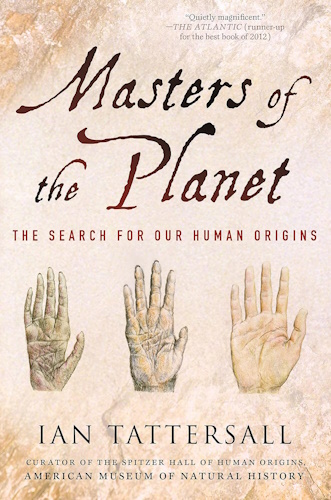

Masters of the Planet: The Search for Our Human Origins (MacSci)

Fifty thousand years ago―merely a blip in evolutionary time―our Homo sapiens ancestors were competing for existence with several other human species, just as their precursors had done for millions of years. Yet something about our species distinguished it from the pack, and ultimately led to its survival while the rest became extinct. Just what was it that allowed Homo sapiens to become masters of the planet? Ian Tattersall, curator emeritus at the American Museum of Natural History, takes us deep into the fossil record to uncover what made humans so special. Surveying a vast field from initial bipedality to language and intelligence, Tattersall argues that Homo sapiens acquired a winning combination of traits that was not the result of long-term evolutionary refinement. Instead, the final result emerged quickly, shocking our world and changing it forever.
About the Author
Ian Tattersall, PhD, is a curator in the Division of Anthropology of the American Museum of Natural History in New York City, where he co-curates the Spitzer Hall of Human Origins. He is the acknowledged leader of the human fossil record, and has won several awards, including the Institute of Human Origins Lifetime Achievement Award. Tattersall has appeared on Charlie Rose and NPR's Science Friday, and has written for Scientific American and Archaeology. He's been widely cited by the media, including The New York Times, BBC, MSNBC, and National Geographic. Tattersall is the author of Becoming Human, among others. He lives in New York City.
Paperback: 288 pages
Publisher: St. Martin's Griffin; Reprint edition (May 28, 2013)
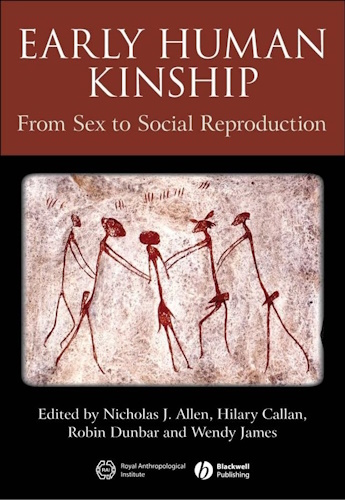

Early Human Kinship: From Sex to Social Reproduction

Early Human Kinship brings together original studies from leading figures in the biological sciences, social anthropology, archaeology, and linguistics to provide a major breakthrough in the debate over human evolution and the nature of society.
- A major new collaboration between specialists across the range of the human sciences including evolutionary biology and psychology; social/cultural anthropology; archaeology and linguistics
- Provides a ground-breaking set of original studies offering a new perspective on early human history
- Debates fundamental questions about early human society: Was there a connection between the beginnings of language and the beginnings of organized 'kinship and marriage'? How far did evolutionary selection favor gender and generation as principles for regulating social relations?
- Sponsored by the Royal Anthropological Institute of Great Britain and Ireland in conjunction with the British Academy
Paperback: 336 pages
Publisher: Wiley-Blackwell; 1 edition (January 4, 2011)


The Secret Cave: Discovering Lascaux

When did humans first start to draw their experiences? Caldecott medalist McCully celebrates “the very beginning of art” in this picture-book introduction to the prehistoric paintings of Lascaux. In 1940, a group of schoolboys in the south of France were searching for a cache of fabled gold when they stumbled across treasure of another kind: underground caverns decorated in a dazzling array of 17,000-year-old paintings and engravings. Uncertain about what they’d really seen, the boys brought in a teacher and then experts to confirm the cave art’s authenticity. Eventually, the French teens grew up to become caretakers of their incredible find. McCully’s text builds suspense in moment-by-moment descriptions of the boys slithering through narrow, dark, subterranean passageways, but it’s the images that have the biggest impact. The dramatically lit, mixed-media scenes evoke both the thrilling exploration and then the astonishing discoveries, reproduced in evocative, textured images. A final spread includes a photo of the boy heroes, as well as more background about the paintings and their preservation, and theories about how the ancient artists created their awe-inspiring works. Grades 1-3. --Gillian Engberg
Hardcover: 40 pages
Publisher: Farrar, Straus and Giroux (BYR) (September 14, 2010)


The World Encyclopedia of Archaeology

The definitive reference on the art and science of archaeology.
The World Encyclopedia of Archaeology is a sweeping exploration of archaeology that spans the globe from the beginning of recorded history and earlier. Here is a comprehensive view of the past as seen through the remnants of civilizations as they emerge and expand. The book begins by defining modern and ancient archaeology and gives the history of archaeology through the centuries. The different types of archaeology are explored, along with the techniques used for each and the problems, concerns and issues archaeologists face today.
The main section of the book details each region of the world, with the authoritative text revealing the fascinating history of important archaeological sites. This global perspective includes more than 700 illustrations. The atlas section with detailed maps provides placements throughout history.
Accurate, in-depth and up to date, The World Encyclopedia of Archaeology is compelling reading. It serves as an outstanding reference for professionals, researchers, history buffs and general readers.
The World Encyclopedia of Archaeology includes:
- The first humans
- Early hunter-gatherers and farmers
- Megalithic builders
- The Bronze Age
- The Greeks and Romans
- The Dark Ages
- Ancient Mesopotamia
- The Persian Empire
- Nomadic states
- The Indus civilization
- China's dynasties and empires
- Japan and Southeast Asian kingdoms
- Early Mesoamericans
- The Maya, Aztec and Inca
- Ancient Egypt and the Upper Nile
- Iron Age Africa
- Australian Aborigines.
Highlights:
- Compiled and written by an international team of archaeologists and historians
- Reveals the most up-to-date findings and their significance
- Organized geographically by region and key sites
- Uncovers the world's most important sites and treasures
- Spans all periods of human settlement
- Locator guide to sites by country
- List of World Heritage Sites
- 18 special features focus on intriguing topics
- Further readings and a glossary
- More than 700 color illustrations
- Attractive maps that show locations of key sites.
Hardcover: 400 pages
Publisher: Firefly Books; 1st Edition edition (October 11, 2007)


Lascaux: Movement, Space and Time

Norbert Aujoulat's definitive book on the Lascaux caves in France, the artistic masterpiece of the Old Stone Age, is the next best thing to being there. That's handy, since you can't go there yourself. Only a few scientists are permitted to visit Lascaux anymore, most eminent among them the author, who heads the parietal art department at the National Center of Prehistory. With impressive authority, he eIaborates the geology, archaeology, and ethology of the site so famously discovered by two spelunking teenagers in 1940, 18,000 years after the cave's heyday. In a way, the book is like the cave itself: a bit daunting, but enormously rewarding the effort. You must traverse great stalagmites of thoroughgoing scientific text translated from French, and are rewarded by enormous vistas of animals painted and scratched on the vast stone walls262 color illustrations of the most important of the 1,963 images in the cave, including 915 animals and one human.
About the Author
Norbert Aujoulat is the departmental head of parietal art at the National Center of Prehistory in France.
Hardcover: 274 pages
Publisher: Harry N. Abrams; First English Edition edition (June 7, 2005)


The Splendour of Lascaux: Rediscovering the Greatest Treasure of Prehistoric Art

On 12 September 1940, four teenagers accidentally stumbled across a hole in the hillside overlooking the village of Montignac, France. This opening the entrance to the Lascaux Cave and its network of chambers brought to light stunning 17,000- year-old paintings that vividly depicted a whole host of animals and figures. The discovery was to become one of the greatest archaeological finds of the 20th century. By the 1950s, however, the sheer number of visitors to the cave was causing the paintings to deteriorate, forcing the Ministry of Cultural Affairs finally to close it to the public in 1963. A key figure at Frances National Centre for Prehistory, Norbert Aujoulat has been fascinated by the Lascaux Cave ever since his first visit back in 1970 and has spent several years researching its ancient art. In successive chapters, he takes us on a thorough exploration of the historic site, detailing the geological and archaeological background of the area and guiding us through the individual chambers and paintings from their very beginnings right up to the present day. By capturing the beauty and essence of these world-renowned masterpieces, this richly illustrated and extensive study enables each and every one of us to experience the magical atmosphere of Lascaux for ourselves.
About the Author
Norbert Aujoulat is the Head of France's National Centre for Prehistory, and the world's expert on the caves at Lascaux.
Hardcover: 280 pages
Publisher: Thames & Hudson Ltd (May 30, 2005)


Dawn of Art: The Chauvet Cave (The Oldest Known Paintings in the World)

The prehistoric paintings recently discovered in Chauvet Cave are twice as old as the paintings of Lascaux, and show both considerable strength and beauty. The discoverers of Chauvet Cave are well known and respected speleologists who maintained impeccable records while exploring their find. It is they who tell the story of their explorations. In many ways this book is reminiscent of Carter's writings about Tutankhamen's tomb with a similar sense of awe at the millennia that had passed between the fabrication of the work and the modern discovery. The text is good, with a clean, easy-to-read translation by prehistorian Paul G. Bahn, who also provides the foreword. It is the photographs, however, that capture the real power and beauty of these paintings, bringing the humanity of their Stone Age artists close to home. Very highly recommended for any collection on art history or prehistory.?Mary Morgan Smith, Northland P.L., Pittsburgh Copyright 1996 Reed Business Information, Inc.
Hardcover: 135 pages
Publisher: Harry N. Abrams; FIRST EDITION IN ENGLISH edition (March 30, 1996)
![]()
![]()